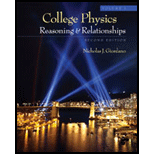
Concept explainers
(a)
The difference in the value of
(a)
Answer to Problem 62P
The difference in the value of
Explanation of Solution
Write the expression for the
Here,
Write the expression for the
Here,
Use equation (II) and (I) to solve for the ratio of value of
Use equation (I) in (III) to solve for
Write the expression for the difference in the value of
Conclusion:
Substitute
Therefore, the difference in the value of
(b)
The difference in the gravitational acceleration between his head and his feet.
(b)
Answer to Problem 62P
The difference in the gravitational acceleration between his head and his feet is
Explanation of Solution
Write the expression for the magnitude of acceleration near the black hole at the person’s feet.
Here,
Write the expression for the magnitude of acceleration near the black hole at the person’s head.
Here,
Use equation (VI) and (VII) to solve for the ratio of value of acceleration between his head and his feet.
Use equation (VIII) and (VI) to solve for
Write the expression for the difference in the value of acceleration between his head and his feet.
Conclusion:
Substitute
Therefore, the difference in the gravitational acceleration between his head and his feet is
Want to see more full solutions like this?
Chapter 5 Solutions
College Physics, Volume 1
- What is the Schwarzschild radius for the black hole at the center of our galaxy if it has the mass of 4 million solar masses?arrow_forwardHow far from the center of the Sun would the net gravitational force of Earth and the Sun on a spaceship be zero?arrow_forwardCalculate the effective gravitational field vector g at Earths surface at the poles and the equator. Take account of the difference in the equatorial (6378 km) and polar (6357 km) radius as well as the centrifugal force. How well does the result agree with the difference calculated with the result g = 9.780356[1 + 0.0052885 sin 2 0.0000059 sin2(2)]m/s2 where is the latitude?arrow_forward
- A space probe is launched from Earth headed for deep space. At a distance of 10,000 km from Earth's center, the gravitational force on it is 900 N. What is the magnitude of the force when the probe is 30,000 km from Earth's center?arrow_forwardthree masses are located in the vertices of an equilateral triangle. calculate the magnitude and direction of the gravitational force on the mass m1. given: m1=38 kg, m2=340 kg, m3=340 kg, r=38 m.arrow_forwardThree masses are located in the vertices of an equilateral triangle. Calculate the magnitude and the direction of the gravitational force on the mass m1. GIVEN m1=38 kg m2=340 kg m3=340 kg r= 38 m G=6.674×10 -11 N·m2/kg2arrow_forward
- Goku's birthplace (in Dragon Ball Z universe) is planet Vegeta which has a really high surface gravity, that is why he can jump really high on Earth because the gravity on the said planet is really wimpy and cannot hold him down. Up to what height can Goku jump on planet Vegeta if he can jump on earth up to a height of 4158.98m and the planet Vegeta has 422.82% stronger gravity? Assume that Goku launched himself on the same initial velocity for both planets. What is his weight on planet Vegeta if his mass is 105.31kg?arrow_forwardIn 2005 astronomers announced the discovery of a large black hole in the galaxy Markarian 766 having clumps of matter orbiting around once every 27 hours and moving at 30,000 km/s. How far are these clumps from the center of the black hole? What is the mass of this black hole, assuming circular orbits? Express your answer in kilograms and as a multiple of our sun's mass.arrow_forwardA space probe is launched from Earth headed for deep space. At a distance of 10,000 miles from Earth's center, the gravitational force on it is 254 lb. What is the size of the force when it is at each of the following distances from Earth's center? (a) 20,000 miles lb(b) 30,000 miles lb(c) 100,000 miles lbarrow_forward
- Two spherical objects have masses of 1.8*10^6 kg and 4.1*10^4 kg. The gravitational attraction between them is 69 N. How far apart are their centers? What is the gravitational acceleration from the center of a spherical object whose mass is 4.3*10^23 kg at a distance of 5.0*10^6 m?arrow_forwardNeutron stars, such as the one at the center of the Crab Nebula, have about the same mass as our sun but a much smaller diameter. If you weigh 650 NN on the earth, what would be your weight on the surface of a neutron star that has the same mass as our sun and a diameter of 24.0 km ? Take the mass of the sun to be ms = 1.99×1030 kg, the gravitational constant to be G = 6.67×10−11 N⋅m2/kg^2, and the free-fall acceleration at the earth's surface to be g = 9.8 m/s^2. Express your weight wstar in newtons.arrow_forward1) On the surface of Venus, which has a mass of 4.869×1024 kg, an object has a weight of 213 N and a mass of 24 kg. What is the radius of Venus? G=6.674×10-11N.m2/kg2.2) What is the gravitational field (in N/kg) 1.400×105 km above the surface of the sun? Radius of the sun= 6.960×105 km, mass of the sun= 1.989×1030 kg, G= 6.674×10-11 N.m2/kg2. 3) Two spherical balls are placed so their centers are 74 m apart. The gravitational attraction between them is 2.362×10-7 N. If the mass of the smaller ball is 3800 kg, find the mass of the other ball.G= 6.674×10-11 N·m2/kg2.arrow_forward
 Classical Dynamics of Particles and SystemsPhysicsISBN:9780534408961Author:Stephen T. Thornton, Jerry B. MarionPublisher:Cengage Learning
Classical Dynamics of Particles and SystemsPhysicsISBN:9780534408961Author:Stephen T. Thornton, Jerry B. MarionPublisher:Cengage Learning Physics for Scientists and Engineers: Foundations...PhysicsISBN:9781133939146Author:Katz, Debora M.Publisher:Cengage Learning
Physics for Scientists and Engineers: Foundations...PhysicsISBN:9781133939146Author:Katz, Debora M.Publisher:Cengage Learning University Physics Volume 1PhysicsISBN:9781938168277Author:William Moebs, Samuel J. Ling, Jeff SannyPublisher:OpenStax - Rice University
University Physics Volume 1PhysicsISBN:9781938168277Author:William Moebs, Samuel J. Ling, Jeff SannyPublisher:OpenStax - Rice University


